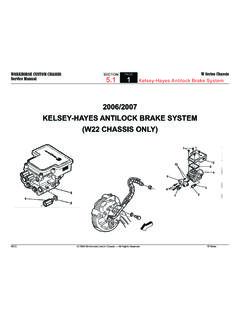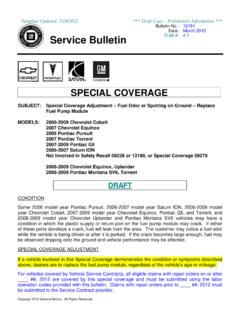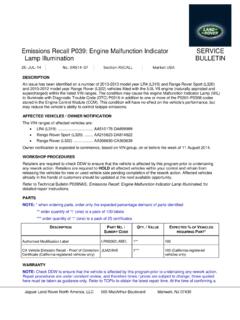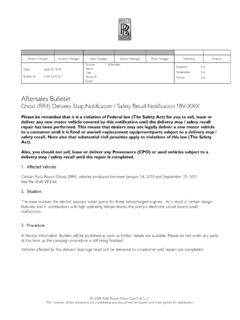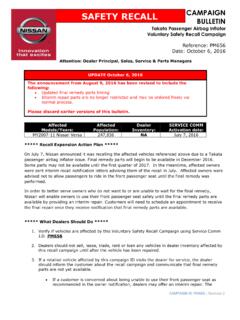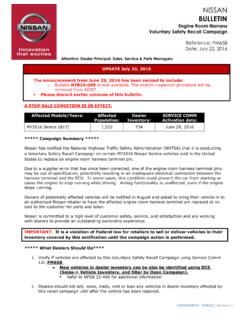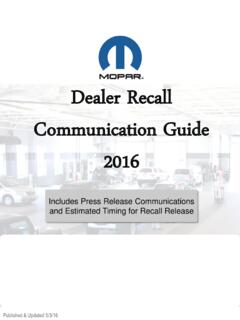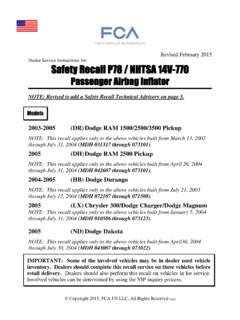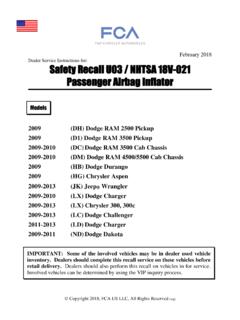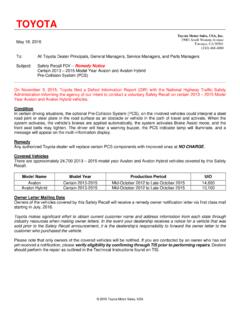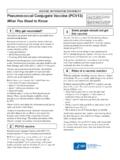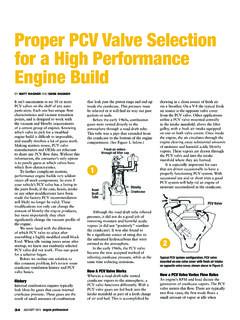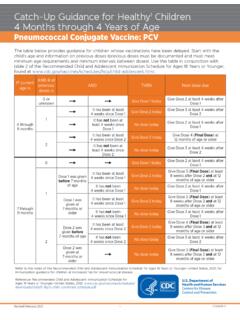Transcription of Bulletin No.: Date: Service Bulletin
1 Copyright 2015 General Motors. All Rights Reserved. Service Bulletin Bulletin No.: date : 14882 March 2015 SPECIAL COVERAGE SUBJECT: Special Coverage Adjustment Plugged PCV Orifice in Intake Manifold MODELS: 2010-2013 Buick LaCrosse 2011-2013 Buick Regal 2012-2013 Buick Verano 2011-2013 Chevrolet Captiva 2010-2014 Chevrolet Equinox 2013 Chevrolet Malibu 2012-2013 Chevrolet Orlando 2010-2013 GMC Terrain Equipped with Ecotec Engine (LAF, LEA or LUK) CONDITION Certain 2010-2013 Buick LaCrosse; 2011-2013 Buick Regal; 2012-2013 Buick Verano; 2011-2013 Chevrolet Captiva; 2010-2014 Chevrolet Equinox; 2013 Chevrolet Mailbu; 2012-2013 Chevrolet Orlando; 2010-2013 GMC Terrain vehicles equipped with a engine (LAF, LEA or LUK) that have experienced high oil consumption may also experience a frozen and/or plugged PCV ( positive crankcase ventilation ) system during cold weather operation.
2 This condition may increase crankcase pressure leading to a rear crankshaft seal oil leak. If the oil leak is ignored or not noticed, an engine clatter noise may be noticeable and/or the engine pressure warning light may illuminate. If this condition is not corrected, continued driving with engine noise and/or the engine oil pressure light illuminated may damage the engine. SPECIAL COVERAGE ADJUSTMENT This special coverage covers the condition described above for a period of 10 years or 120,000 miles (193,000 km), whichever occurs first, from the date the vehicle was originally placed in Service , regardless of ownership. Dealers are to perform a crankcase pressure check, and if required, remove the intake manifold and clear the PCV orifice. The repairs will be made at no charge to the customer. For vehicles covered by Vehicle Service Contracts, all eligible claims with repair orders on or after March 4, 2015, are covered by this special coverage and must be submitted using the labor operation codes provided with this Bulletin .
3 Claims with repair orders prior to March 4, 2015, must be submitted to the Service Contract provider. Page 2 March 2015 Bulletin No.: 14882 VEHICLES INVOLVED All involved vehicles are identified by Vehicle Identification Number on the Applicable Warranties section in GM Global Warranty Management system. Dealership Service personnel should always check this site to confirm vehicle involvement prior to beginning any required inspections and/or repairs. It is important to routinely use this tool to verify eligibility because not all similar vehicles may be involved regardless of description or option content. PART INFORMATION Parts required to complete this special coverage are to be obtained from General Motors Customer Care and Aftersales (GMCCA). Note: Use the vehicle identification number (VIN), SI and the GM Electronic Parts Catalog to determine which parts to order. The Crankshaft Rear Oil Seal Replacement procedure in SI states what parts are required to complete the repair.
4 For example, gaskets, one-time use fasteners, and fluids. Part Number Description Quantity/Vehicle 12591866 Crankshaft Rear Oil Seal 1 Service PROCEDURE Crankshaft Rear Oil Seal Replacement Determine if the crankshaft rear oil seal requires replacement. If the crankshaft rear oil seal does NOT require replacement, no further action is required. This Bulletin provides coverage for replacing the crankshaft rear oil seal, performing a positive crankcase ventilation (PCV) pressure test and, if necessary, unplugging the PCV system. If the crankshaft rear oil seal requires replacement, Refer to Crankshaft Rear Oil Seal Replacement in SI. Proceed to positive crankcase ventilation (PCV) Pressure Test in this Bulletin AFTER replacing the crankshaft rear oil seal replacement. positive crankcase ventilation (PCV) Pressure Test Special Tools EN 23951 Valve Manometer Ecotec Engine -- LAF, LEA, LUK Page 3 March 2015 Bulletin No.
5 : 14882 4078380 1. Disconnect positive crankcase ventilation (PCV) hose at the air box (1). 2. Install EN 23951 valve manometer into fresh air line. 3. Start the vehicle and let the vehicle idle. Observe if there is positive or negative pressure on the manometer gauge. Note: With a properly operating PCV system and the manometer installed, there may be a whistle noise coming from the front or rear of the engine when the engine RPM is raised. This is normal when the vacuum in the engine is increased. The front /rear seal will open up and let air pass, which produces the whistle noise. 4. Increase engine RPM to 1500 RPM for 2-3 seconds. Determine if there is positive or negative pressure on the manometer gauge. If the manometer gauge indicates zero or positive pressure when the engine RPM is raised, the PCV port in the intake manifold needs to be unplugged. Proceed to step 5. If the manometer gauge indicates negative pressure, the PCV system is NOT clogged.
6 Reinstall the positive crankcase ventilation (PCV) hose at the air box (1). No further action is required. 5. Remove the intake manifold. Refer to Intake Manifold Replacement in SI. 3704956 Page 4 March 2015 Bulletin No.: 14882 3704955 6. Clean ice, sludge, water, and carbon out of the PCV pipes, hoses, the PCV nipple on the cam cover, the PCV orifice between the number 2 and number 3 intake runners, PCV orifice (1) in the cylinder head (use a 1/16 in drill bit as shown in photograph) and the throttle body. Refer to photographs. Also inspect the related PCV hoses and connections for potential damage. 7. Install the intake manifold. Refer to Intake Manifold Replacement in SI. CUSTOMER REIMBURSEMENT - For US Customer requests for reimbursement of previously paid repairs to correct the condition described in this Bulletin are to be submitted to the dealer by March 31, 2016, unless otherwise specified by state law.
7 If this is not convenient for the customer, they may mail the completed Customer Reimbursement Request Form and all required documents to the GM Customer Assistance Center. Repairs must have occurred within the 10 years of the date the vehicle was originally placed in Service , or 120,000 miles, whichever occurs first. All reasonable and customary costs to correct the condition described in this Bulletin should be considered for reimbursement. Any questions or concerns should be reviewed with your GM representative prior to processing the request. When a customer requests reimbursement, they must provide the following: A completed Customer Reimbursement Request Form. This form is mailed to the customer or can be obtained through GM GlobalConnect. The name and address of the person who paid for the repair. Paid receipt confirming the amount of the repair expense, a description of the repair, and the person or entity performing the repair.
8 IMPORTANT: GM requires dealers to approve or deny a reimbursement request within 30 days of receipt. If a reimbursement request is approved, the dealer should immediately issue a check to the customer and submit an appropriate warranty transaction for the incurred expense. If a reimbursement request is denied, the dealer MUST provide the customer with a clear and concise explanation, in writing, as to why the request was denied. The bottom portion of the Customer Reimbursement Request Form may be used for this purpose. If the denial was due to missing documents, the customer can resubmit the request when the missing documents are obtained, as long as it is still within the allowed reimbursement period. Page 5 March 2015 Bulletin No.: 14882 Warranty transactions for customer reimbursement of previously paid repairs are to be submitted as required by GM Global Warranty Management.
9 Additional information can also be found in Warranty Administration Bulletin 11-00-89-004. CUSTOMER REIMBURSEMENT - For Canada and Export Customer requests for reimbursement of previously paid repairs to correct the condition described in this Bulletin are to be submitted to the dealer prior to or by March 31, 2016. Repairs must have occurred within the 10 years of the date the vehicle was originally placed in Service , or 193,000 kilometers, whichever occurs first. When a customer requests reimbursement, they must provide the following: - Proof of ownership at time of repair. - Original paid receipt confirming the amount of unreimbursed repair expense(s) (including Service Contract deductibles), a description of the repair, and the person or entity performing the repair. All reasonable and customary costs to correct the condition described in this Bulletin should be considered for reimbursement.
10 Any questions or concerns should be reviewed with your GM representative prior to processing the request. COURTESY TRANSPORTATION For US and Canada The General Motors Courtesy Transportation program is intended to minimize customer inconvenience when a vehicle requires a repair that is covered by the New Vehicle Limited Warranties. The availability of courtesy transportation to customers whose vehicles are within the warranty coverage period and involved in a product program is very important in maintaining customer satisfaction. Dealers are to ensure that these customers understand that shuttle Service or some other form of courtesy transportation is available and will be provided at no charge. Dealers should refer to the General Motors Service Policies and Procedures Manual for Courtesy Transportation guidelines. Page 6 March 2015 Bulletin No.
